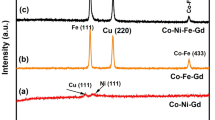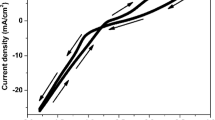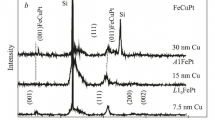Abstract
NiFe/Cu superlattices having different ferromagnetic NiFe layer thicknesses were grown on polycrystalline titanium substrate from a solution containing nickel, iron and copper ions under potentiostatic control. The NiFe layer thickness of the superlattices was changed from 1.5 to 8 nm while the Cu layer thickness was kept constant at 1 nm. The energy dispersive X-ray analysis revealed that, as the NiFe layer thickness increases, the Ni content of the samples increases, the Cu content decreases and Fe content decreases slightly. NiFe/Cu superlattices were polycrystalline face centred cubic (fcc) structure with NiFe and Cu layers adopting the fcc structure due to the low amount of Fe content in the deposits. The crystal orientation of the superlattices was obtained as {111}. The lattice parameters were calculated and slightly decrease from 0.36012 to 0.35382 nm with increase in the NiFe layer thickness. According to the Scanning Electron Microscopy images, when the NiFe layer thickness increases, the cauliflower region becomes less and then the granular-like regions were seen on the surface of the samples. And, the magnetic measurements showed that the saturation magnetization gradually increased from 12.9 to 291.3 emu/cm3 with increasing NiFe layer thickness from 1.5 to 8 nm, confirming the increase of the Ni contents and decrease of the Cu amount in the superlattices. Also, the coercivities ranging from 25.1 to 63.2 Oe are between the soft and hard magnetic properties. The superlattices having NiFe layer thickness less than 5 nm showed giant magnetoresistance (GMR) while the superlattices having greater NiFe layer thicknesses showed aniotropic magnetoresistance. The GMR values of up to 2% were observed for NiFe/Cu superlattices deposited on titanium substrate. It is seen that this material may have the potential applications in sensor and recording media.









Similar content being viewed by others
References
A. Tokarz, P. Wieczorek, A.K. Lis, J. Morgiel, Microstructure of electrodeposited NiFe/Cu multilayers. J. Microsc. 237, 456–460 (2010)
N. Rajasekaran, S. Mohan, Giant magnetoresistance in electrodeposited films: current status and the influence of parameters. Crit. Rev. Solid State Mater. Sci. 37(3), 158–180 (2012)
I. Bakonyi, L. Peter, Electrodeposited multilayer films with giant magnetoresistance (GMR): progress and problems. Prog. Mater Sci. 55(3), 107–245 (2010)
K. Atrak, A. Ramazani, S.T. Fardood, Eco-friendly synthesis of Mg0.5Ni0.5AlxFe2−xO4 magnetic nanoparticles and study of their photocatalytic activity for degradation of direct blue 129 dye. J. Photochem. Photobiol., A 382, 111942 (2019)
S.T. Fardood, A. Ramazani, Z. Golfar, S.W. Joo, Green synthesis of Ni-Cu-Zn ferrite nanoparticles using tragacanth gum and their use as an efficient catalyst for the synthesis ofpolyhydroquinoline derivatives. Appl. Organomet. Chem. 31, 3823 (2017)
S.T. Fardood, A. Ramazani, S. Moradi, A novel green synthesis of nickel oxide nanoparticles using Arabic gum. Chem. J. Moldova 12(1), 115–118 (2017)
H.P. Sun, Z. Zhang, W.D. Wang, Microstructure of columnar crystallites in Ni80Fe20/Cu magnetic multilayers. J. Appl. Phys. 87(6), 2835–2839 (2000)
R. Pereira, P.C. Camargo, A.J.A. de Oliveira, E.C. Pereira, Modulation of the morphology, microstructural and magnetic properties on electrodeposited NiFeCu alloys. Surf. Coat. Technol. 311, 274–281 (2017)
M. Alper, K. Attenborough, R. Hart, S.J. Lane, D.S. Lashmore, C. Younes, W. Schwarzacher, Giant magnetoresistance in electrodeposited superlattices. Appl. Phys. Lett. 63(15), 2144–2146 (1993)
H.K. Kim, D.W. Chun, J.H. Han, K.B. Kim, W.Y. Jeung, Effects of external magnetic field on magnetic properties and surface morphology of electrodeposited CoFeNi alloys. Phys. Stat. Sol. (A) 204(12), 4104–4107 (2007)
S.Z. Hua, D.S. Lashmore, L. Salmanca-Riba, W. Schwarzacher, L.J. Swartzendruber, R.D. McMichael, L.H. Bennett, R. Hart, Giant mmagnetoresistance peaks in CoNiCu/Cu multilayers grown by electrodeposition. J. Appl. Phys. 76, 6519–6521 (1994)
S. Zsurzsa, L. Peter, L.F. Kiss, I. Bakonyi, Magnetic and magnetoresistance studies of nanometric electrodeposited Co films and Co/Cu layered structures: influence of magnetic layer thickness. J. Magn. Magn. Mater. 421, 194–206 (2017)
C.B. Ene, G. Schmitz, R. Kirchheim, A. Hutten, Stability and thermal reaction of GMR NiFe/Cu thin films. Acta Mater. 53(12), 3383–3393 (2005)
M. Hecker, D. Tietjen, H. Wendrock, C.M. Schneider, N. Cramer, L. Malkinski, R.E. Camley, Z. Celinski, Thermal stability and degradation mechanism of NiFe/Cu giant magnetoresistance multilayer systems. J. Magn. Magn. Mater. 247, 62–69 (2002)
K. Attenborough, R. Hart, S.J. Lane, M. Alper, W. Schwarzacher, Magnetoresistance in electrodeposited Ni-Fe-Cu/Cu multilayers. J. Magn. Magn. Mater. 148, 335–336 (1995)
E. Chassaing, P. Nallet, M.F. Trichet, Electrodeposition of Cu/Fe20Ni80 magnetic multilayers. J. Electrochem. Soc. 143, 98–100 (1996)
H. Kuru, H. Kockar, M. Alper, Giant magnetoresistance (GMR) behaviour of electrodeposited NiFe/Cu multilayers: dependence of non-magnetic and magnetic layer thickness. J. Magn. Magn. Mater. 444, 132–139 (2017)
H. Kuru, H. Kockar, M. Alper, M. Haciismailoglu, Relation between ferromagnetic layer thickness (NiCu) and properties of NiCu/Cu multilayers. J. Mater. Sci Mater. Elecron. 26, 5014–5021 (2015)
M. Haciismailoglu, M. Alper, Effect of electrolyte pH and Cu concentration on microstructure of electrodeposited Ni–Cu alloy films. Surf. Coat. Technol. 206, 1430–1438 (2011)
Y. Chen, Q.P. Wang, C. Cai, Y.N. Yuan, F.H. Cao, Z. Zhang, J.Q. Zhang, Electrodeposition and characterization of nanocrystalline CoNiFe films. Thin Solid Films 520, 3553–3557 (2012)
Z. Zhang, W.H. Leng, J.Q. Zhang, J.M. Wang, C.N. Cao, Study on the behavior of Zn-Fe alloy electroplating. J. Electroanal. Chem. 516, 127–130 (2001)
S. Sam, G. Fortas, A. Guittoum, N. Gabouze, S. Djebbar, Electrodeposition of NiFe films on Si(100) substrate. Surf. Sci. 601, 4270–4273 (2007)
V. Torabinejad, M. Aliofkhazraei, S. Assareh, M.H. Allahyarzadeh, A.S. Roughaghdam, Electrodeposition of Ni-Fe alloys, composites and nano coatings—a review. J. Alloy. Compd. 691, 841–859 (2017)
A. Vicenzo, P.L. Cavallotti, Growth modes of electrodeposited cobalt. Electrochim. Acta 49(24), 4079–4089 (2004)
S. Esmaili, M.E. Bahrololoom, L. Peter, Magnetoresistance of electrodeposited NiFeCu alloys. Thin Solid Films 520, 2190–2194 (2012)
B. Cullity, Elements of X-ray Diffraction (Addison-Wesley, Massachusets, 1978)
B.N. Mondal, A. Basumallick, P.P. Chattopadhyay, Correlation of microstructure and magnetic properties in Cu-Co-Ni alloys. Mater. Sci. Eng. B 166, 174–179 (2010)
M.S. Khatri, H. Schlörb, S. Fähler, L. Schultz, Correlation of crystallographic structure and magnetic properties of electrodeposited Co-rich Co-Pt films. Phys. Status Solidi 208, 104–108 (2011)
J. Yi, Z. Yongzhong, J. Ding, G.M. Chow, Z.L. Dong, T. White, X.Y. Gao, A.T.S. Wee, X.J. Yu, An investigation of structure, magnetic properties and magnetoresistance of Ni films prepared by sputtering. J. Magn. Magn. Mater. 284(1), 303–311 (2004)
D. Jiles, Introduction to Magnetism and Magnetic Materials (Chapman and Hall, London, 1996)
S.K. Ghosh, A.K. Grover, P. Chowdhury, S.K. Gupta, G. Ravikumar, D.K. Aswal, M.S. Kumar, R.O. Dusane, High magnetoresistance and low coercivity in electrodeposited Co/Cu granular multilayers. Appl. Phys. Lett. 89, 132507–132509 (2006)
M. Haciismailoglu, M. Alper, H. Kockar, O. Karaagac, Electrodeposition and characterization of Co/Cu multilayers. Acta Phys. Pol. A 129(4), 773–775 (2016)
S.M.S.I. Dulal, E.A. Charles, S. Roy, Characterisation of Co-Ni(Cu)/Cu multilayers deposited from a citrate electrolyte in a flow channel cell. Electrochem. Acta 49, 2041–2049 (2004)
S.M.S.I. Dulal, E.A. Charles, Optimisation of electrochemical process parameters for giant magnetoresistance of electrodeposited NiCo(Cu)/Cu multilayers. Trans. IMF 86(5), 260–266 (2008)
H. Kuru, H. Kockar, M. Alper, Electrodeposited NiFeCu/Cu multilayers: effect of Fe ion concentration on properties. J. Magn. Magn. Mater. 373, 135–139 (2015)
Acknowledgments
This work was supported by Balikesir University, Turkey under Research Grant no. BAP 2015/192. The authors would like to thank State Planning Organization,Turkey under Grant No. 2005K120170 for VSM system, Scientific and Technical Research Council of Turkey (TUBITAK) under Grant No. TBAG-1771 for electrodeposition system and Balikesir University Research Grant No. BAP 2001/02, 2005/38 for MR system. The authors are very grateful to the Bilkent University/Turkey – UNAM, Institute of Materials Science and Nanotechnology for the EDX, the XRD measurements, and the SEM images by using BAP 2013/85. B. Ülker was thanked for primarily contribution of some sample productions with BAP 2016/144 under the author’s instructions.
Author information
Authors and Affiliations
Corresponding author
Additional information
Publisher's Note
Springer Nature remains neutral with regard to jurisdictional claims in published maps and institutional affiliations.
Rights and permissions
About this article
Cite this article
Kuru, H., Aytekin, N.Ç., Köçkar, H. et al. Effect of NiFe layer thickness on properties of NiFe/Cu superlattices electrodeposited on titanium substrate. J Mater Sci: Mater Electron 30, 17879–17889 (2019). https://doi.org/10.1007/s10854-019-02140-z
Received:
Accepted:
Published:
Issue Date:
DOI: https://doi.org/10.1007/s10854-019-02140-z




